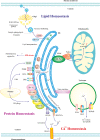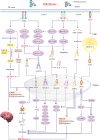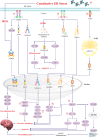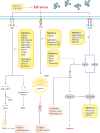ER stress and UPR in Alzheimer's disease: mechanisms, pathogenesis, treatments
- PMID: 35970828
- PMCID: PMC9378716
- DOI: 10.1038/s41419-022-05153-5
ER stress and UPR in Alzheimer's disease: mechanisms, pathogenesis, treatments
Abstract
Alzheimer's disease (AD) is a devastating neurodegenerative disorder characterized by gradual loss of memory and cognitive function, which constitutes a heavy burden on the healthcare system globally. Current therapeutics to interfere with the underlying disease process in AD is still under development. Although many efforts have centered on the toxic forms of Aβ to effectively tackle AD, considering the unsatisfactory results so far it is vital to examine other targets and therapeutic approaches as well. The endoplasmic reticulum (ER) stress refers to the build-up of unfolded or misfolded proteins within the ER, thus, perturbing the ER and cellular homeostasis. Emerging evidence indicates that ER stress contributes to the onset and development of AD. A thorough elucidation of ER stress machinery in AD pathology may help to open up new therapeutic avenues in the management of this devastating condition to relieve the cognitive dementia symptoms. Herein, we aim at deciphering the unique role of ER stress in AD pathogenesis, reviewing key findings, and existing controversy in an attempt to summarize plausible therapeutic interventions in the management of AD pathophysiology.
© 2022. The Author(s).
Conflict of interest statement
The authors declare no competing interests.
Figures




Similar articles
-
Endoplasmic reticulum stress in Alzheimer's disease: Molecular mechanisms and therapeutic prospects.Life Sci. 2023 Oct 1;330:121983. doi: 10.1016/j.lfs.2023.121983. Epub 2023 Jul 29. Life Sci. 2023. PMID: 37524162 Review.
-
Molecular Mechanisms of ER Stress and UPR in the Pathogenesis of Alzheimer's Disease.Mol Neurobiol. 2020 Jul;57(7):2902-2919. doi: 10.1007/s12035-020-01929-y. Epub 2020 May 19. Mol Neurobiol. 2020. PMID: 32430843 Review.
-
Endoplasmic reticulum stress as a novel neuronal mediator in Alzheimer's disease.Neurol Res. 2015 Apr;37(4):366-74. doi: 10.1179/1743132814Y.0000000448. Epub 2014 Oct 13. Neurol Res. 2015. PMID: 25310352 Review.
-
Emerging roles of ER stress in the etiology and pathogenesis of Alzheimer's disease.FEBS J. 2018 Mar;285(6):995-1011. doi: 10.1111/febs.14332. Epub 2017 Dec 15. FEBS J. 2018. PMID: 29148236 Review.
-
Crosstalk between endoplasmic reticulum stress and brain inflammation in Alzheimer's disease.Neuropharmacology. 2018 Jul 1;136(Pt B):350-360. doi: 10.1016/j.neuropharm.2017.11.016. Epub 2017 Nov 10. Neuropharmacology. 2018. PMID: 29129774 Review.
Cited by
-
Frontotemporal Dementia P301L Mutation Potentiates but Is Not Sufficient to Cause the Formation of Cytotoxic Fibrils of Tau.Int J Mol Sci. 2023 Oct 8;24(19):14996. doi: 10.3390/ijms241914996. Int J Mol Sci. 2023. PMID: 37834443 Free PMC article.
-
Transcriptome analysis reveals organ-specific effects of 2-deoxyglucose treatment in healthy mice.PLoS One. 2024 Mar 7;19(3):e0299595. doi: 10.1371/journal.pone.0299595. eCollection 2024. PLoS One. 2024. PMID: 38451972 Free PMC article.
-
Ceapin-A7 potentiates lipopolysaccharide-induced endothelial injury.J Biochem Mol Toxicol. 2023 Nov;37(11):e23460. doi: 10.1002/jbt.23460. Epub 2023 Jul 11. J Biochem Mol Toxicol. 2023. PMID: 37431958 Free PMC article.
-
Proposed mechanisms of tau: relationships to traumatic brain injury, Alzheimer's disease, and epilepsy.Front Neurol. 2024 Jan 5;14:1287545. doi: 10.3389/fneur.2023.1287545. eCollection 2023. Front Neurol. 2024. PMID: 38249745 Free PMC article.
-
Early- and Late-Onset Alzheimer's Disease: Two Sides of the Same Coin?Diseases. 2024 May 22;12(6):110. doi: 10.3390/diseases12060110. Diseases. 2024. PMID: 38920542 Free PMC article. Review.
References
Publication types
MeSH terms
LinkOut - more resources
Full Text Sources
Medical

